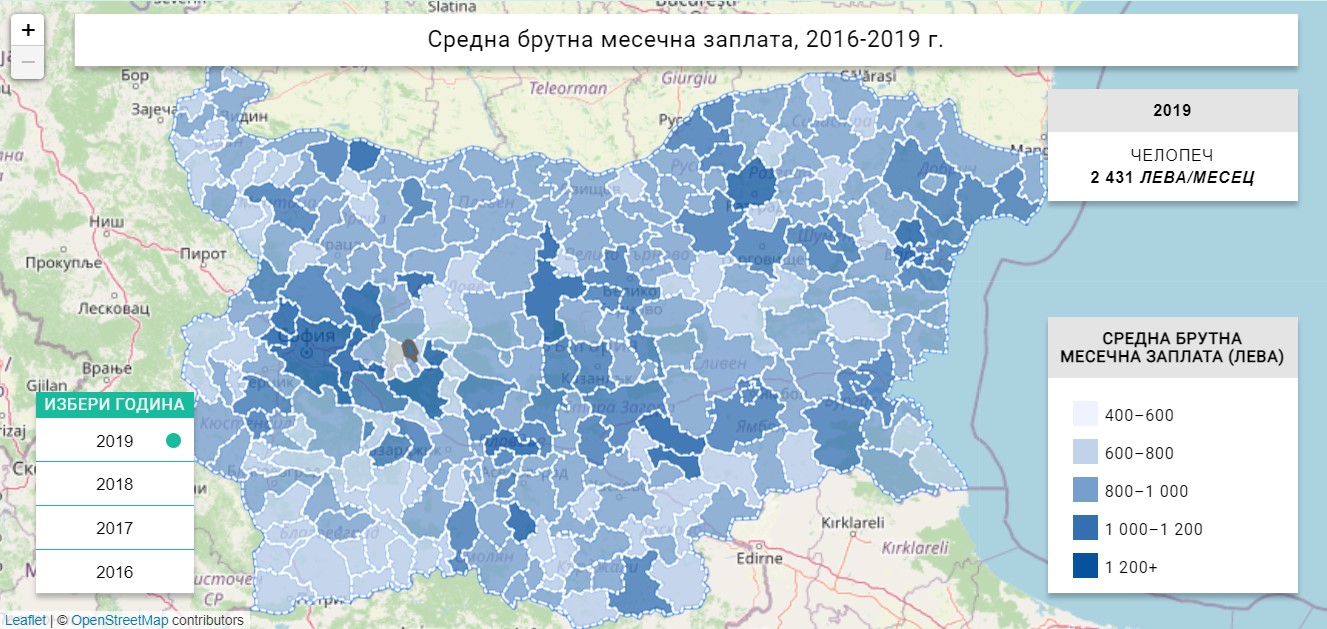The IME marks the beginning of the second year of its 265 Economic Stories initiative.
BIA is a partner of the initiative.
The initiative of the Institute for Market Economy (IME) for dissemination, visualization, and analysis of municipal data - "265 stories about the economy" (www.265obshtini.bg) - has started its second year. The effort of IME is supported by leading Bulgarian companies and business associations, aiming to increase knowledge and understanding of the development of the 265 municipalities in Bulgaria. The huge interest in the published data and the interactive maps in the platform are one of the most successful IME initiatives of 2020.
Where are the highest salaries in the country amidst the pandemic?
Traditionally, information about wages in different municipalities is of great interest. The IME begins its second year with a municipal pay card from 2019. The data show the average gross monthly salary of employees in the 265 municipalities in the country - this includes both employees in the private and in the public sectors. For the first time, the payroll map provides data for a longer timeline - it covers the period between 2016-2019.
With an average gross monthly salary of BGN 2,431, the municipality of Chelopech is the winner for 2019. The second place goes to Kozloduy with an average salary of BGN 2,133, followed by Radnevo - BGN 1,826, and Pirdop - BGN 1,785. Sofia Municipality comes in 5th with BGN 1,753. The remaining municipalities in the top 10 are Galabovo (BGN 1,732), Devnya (BGN 1,614), Elin Pelin (BGN 1,469), and Panagyurishte. BGN 1,431). For a subsequent year, the highest salaries in the country are handed out in small municipalities with large employers - the Srednogorie, a territory of developed mining and related processing industry, as well as other municipalities with large enterprises in the energy sector.
Industrial municipalities on the periphery of the largest economic centers also show impressive results. The top 20 in terms of wages in the country include 1) the municipalities of Elin Pelin, Bozhurishte, Kostinbrod, and Botevgrad which are in the perimeter of Sofia; 2) the municipalities of Devnya, Suvorovo, and Beloslav near Varna and 3) the municipality of Maritsa near Plovdiv. The successful model of the three leading centers in the country - Sofia, Plovdiv, and Varna, is due to the development of services within the city - driven by rapid growth in the digital sphere and strong industry on the outside, which focuses on higher added value and effects good salaries.
The positive processes before the pandemic lead to an increase in the average salary in each district for the period 2016-2019 (see dynamics map). For three years the average salary of employees in more than half of the Bulgarian municipalities has increased by 30% - 40%. Small municipalities are once more in leading positions, with Krumovgrad municipality in the top 3, where the average salary increased by 58% for the period 2016-2019. The latter is provoked by investments in the mining industry and the effect on suppliers and field construction activities. The large municipalities - Sofia, Plovdiv, and Varna, are also reporting good growth - within 30-35%, which is also due to the growth of employees and salaries in the digital sphere.






